Kodava people
| Total population | |
|---|---|
| (approx) 160,000 | |
| Regions with significant populations | |
| Kodagu (Coorg), Bangalore, Mysore | |
| Languages | |
| Kodava takk | |
| Related ethnic groups | |
| Amma Kodava, Kodagu Heggade, Kodava Maaple, Kodagu Gowda |
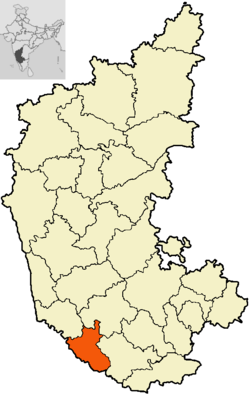
The term Kodava has two related usages. Firstly, it is the name of the Kodava language and culture followed by a number of communities from Kodagu. Secondly, within the Kodava - speaking communities and region (Kodagu) it describes the dominant Kodava people. The Kodavas (Kodava, anglicised as Coorgs), are considered a patrilineal ethno-lingual tribe from the region of Kodagu, (in Karnataka state of southern India), who natively speak the Kodava language. Traditionally they were land-owning agriculturists with martial customs. They practice family exogamy and caste endogamy. [1][2][3]
Origin
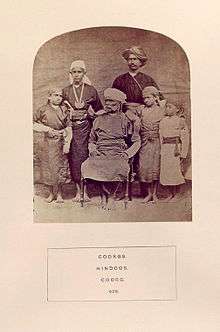
The words Kodava (the indigenous people, language and culture) and Kodagu (the land) come from the same root word 'Koda' of unknown meaning. Some claim it means 'hills', others say it means 'west' but both relate to the Western Ghats' location. Kodagu is called Kodavu in the native Kodava language. The community members were called Kodava by the other natives and Coorgs (or Coorgis) by the British. They are ethnically and culturally distinct people. For centuries, the Kodavas have lived in Kodagu cultivating paddy fields, maintaining cattle herds and carrying arms during war.[1]
Indigenous origin
There are a variety of theories as to the origin of the Kodava, including theories of them being either the indigenous inhabitants of their region, or of foreign origins before two thousand years ago. However the foreign theories are mere speculations because they have found no concrete evidences.
- As per the indigenous theory, Kodavas are the native inhabitants of Kodagu who learnt and practised agriculture. Hence they were an ancient warlike tribe which got civilised over the centuries to become prosperous and very well-cultured.
- Kodavas (Coorgs) may be the descendants of the broad headed (brachycephalic) stock who entered into the Indus Valley during the Mohenjodaro period before the Indo-Aryans and later migrated to the Coorg region (Hutton, as quoted by Balakrishnan in 1976).
Other origin speculations
- One view is that the Kodavas are descendants of Scythians (Connor 1870, Rice 1878). According to yet another but similar view, the Kodavas belong to the Indo-Scythian race like the Sakas, the Western Kshatrapas and the Nagavamshi Nairs.
- Lt. Col. K. C. Ponnappa's research book, A Study of the Origins of Coorgs, claimed that the ancestors of the Kodavas were either pre-Muslim Kurds or pre-Christian Caucasians[4] while Ponjanda S. Appaiah claimed that they were of the Babylonian culture and related to the Barzani Kurds.[5]
Consensus
- Kannada inscriptions speak of this region as being called Kudagu nad (parts of Kodagu, Western Mysore and Kerala) as well. Both the name of the natives and of the region are synonymous (Kodava-Kodavu; Kodaga-Kodagu; Coorgs-Coorg).[6]
- The earliest writings found in Kodagu, inscriptions dated around 800-900 AD, speak of Kadangas (defensive structures made by the Kodavas), the Entu Okkalu (Ettu Okka, eight original agrarian, later local chieftain, clans), the (now extinct) Kunindora family and give other similar references to the Kodavas.[7]
- A thousand-year old inscription, an inscription dated 1174 AD, found in Periyapatna (a town near Kodagu) mentions a battle in which a local chieftain gathered the Kodavas from different parts of Kodagu and led them in war.[7][6]
- In 1398 AD, when Vijaynagar ruled South India, Mangaraja, a Kannada poet, wrote in his lexicon about the Kodavas saying that they were a warrior people who were fond of hunting game for sport.[6]
Historians agree that the Kodavas have lived in Kodagu for over a thousand years, hence they are the earliest agriculturists and probably the oldest settled inhabitants of the area.[6][8][9]
History

Puranic association
The Hindu Puranas (Kaveri Purana of Skanda Purana) claim that Chandra Varma, a Chandravanshi Kshatriya (lunar dynasty warrior) and son of Emperor of Matsya Desha, was the ancestor of this 'fierce' race, the Kodavas. An ardent devotee of Goddess Parvati, he had gone on pilgrimage to several holy places all over India. Chandra Varma had a privy army who escorted him on his campaigns until he came into Kodagu(Coorg). Coorg, the source of the River Kaveri, was uninhabited jungle land when he arrived to settle here. Thereafter he became the first Raja of the Coorg principality. He had 11 sons, the eldest among them was Devakantha who later succeeded him as Raja. They were married to the daughters of the Raja of Vidarbha. These sons and their descendants cultivated and populated the land of Kodagu, they came to be called the Kodava race.[10]
Rajas
Early Rajas
The Kadamba ruled North Karnataka along with Goa and parts of Maharashtra while the Gangas ruled South Karnataka and parts of Andhra and Tamil Nadu prior to 1000AD. The regions of Hassan, Kodagu (Coorg), Tulunad and Waynad were ruled between them. Later the cholas entered Karnataka to rule, but it was short lived. The Hoysalas succeeded them and ruled Southern Karnataka (including Tulunad and Coorg) and parts of Tamil Nadu. In the aftermath of the Delhi Sultanate invasion of South India (around 1319) the Vijaynagara Hindu Empire arose to rule South India until their downfall in the 16th century.
Haleri Rajas
From around 1600 until 1834 the Haleri Rajas ruled over Coorg. Under the Paleri (Haleri) dynasty Kodagu attained a status as an independent kingdom. When Linga Raja I died, Hyder Ali imprisoned the royal family and took direct control of Kodagu. This enraged the Kodavas and they started heckling the Muslim garrison in Madikeri. In 1782 the Kodavas took power back from Hyder Ali.
In the same year, Hyder Ali died and his son Tippu Sultan started his ambitious expansion of the Mysore kingdom. In 1784, Tippu attacked Kodagu, while returning from Mangalore to Srirangapattana, his capital city. He retained control of Kodagu for sometime by very repressive means. Both Hyder Ali and Tippu were interested in Kodagu because of its abundant rice crop which brought much revenue to the state treasury.[11]
Tippu never could continuously hold power in Kodagu. As soon as he turned his back on Kodagu, the local heroes revolted and took power back from the Muslim rulers. Tippu returned to reclaim control though he found the Kodavas very hostile.
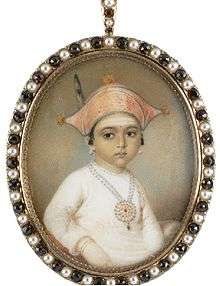
In 1788, Dodda Vira Rajendra, who had been taken prisoner, escaped and defeated Tippu and recovered his kingdom. In 1790 Dodda Vira Rajendra signed a treaty with the British, who promised to protect his kingdom against Tippu’s onslaught. In 1792 Kodagu became independent of Mysore once again. Eventually, the Kodavas backed the British troops and Tippu fell in the year 1799. In addition to the kings' samadhis (tombs), samadhis were built for the Diwans. Samadhis were built for army chief Biddanda Bopu, who was the commander-in-chief for the army of Dodda Vira Rajendra, and his son Biddanda Somaiah. On the samadhi of Biddanda Bopu, there is a plate carved in Kannada praising him for his bravery shown in the wars fought against Tipu Sultan.[12]
British Raj
Coorg War
In 1834 the last of the Haleri Rajas Chikka Vira Raja fell out of favour with the British who then intervened by invading Kodagu. A short but bloody campaign occurred in which a number of British men and officers were killed. Near Somwarpet where the Coorgs were led by Mathanda Appachu the resistance was most furious. But this Coorg campaign came to a quick end when the Raja sent his Diwan Apparanda Bopu to surrender to the British and lead them from Kushalnagar into Madikeri. Thereafter Kodagu was annexed by the British and the Raja was exiled.[13][14] Apparanda Bopu and Cheppudira Ponnappa were retained as the Dewans of Coorg.[12]
Freedom Struggle
The so-called Coorg rebellion of 1837 actually occurred in Sulya which was separated from Coorg Province in 1834 and attached to South Canara district of Madras Province. Led by Guddemane Appaiah Gowda and others it was not due to Gowdas alone nor opposed by all Kodavas, this was a 'divide-and-rule' propaganda of the British Raj. "A large number of people from Coorg settled in Lower Coorg also participated in the revolt...There are no reliable sources which prove such a bitter hatred among the Coorgs and the Gowdas of Sullia." In fact, Kodavas from Nalkunadu led by Subedar Mandira Uthaiah (Nalknadu Uttu) actively participated in the revolt.[15]
During British rule, Coorgs entered politics, government service, medicine, education, and law. Under British protection, Kodagu became a State with nominal independence (Coorg State).[16] The British recognised the exceptional martial abilities of the Kodavas and used them in their army.[17] Many Kodavas fought in the two World Wars. They earned a reputation as able commanders and brave fighters both under the British rule as well as post independent India. Eventually, famous sons of Kodagu became prominent members of the armed forces of India. General K.S. Thimayya DSO and Field Marshal K.M. Cariappa OBE are among the notables.Dewan Bahadur Ketolira Chengappa was the last Chief Commissioner of Coorg in 1947. In 1950 Coorg was recognised as one of 27 different states of the Indian Union but in 1956 the state of Coorg was merged into Mysore (now Karnataka).[6][17]
There were many freedom fighters among the Kodavas as well, like Iynanda P. Kariappa, who was a leader of the INC and was sent to Delhi Jail by the British, he later on became the first MLA of Coorg State, and was also the District board President. Pandyanda Belliappa (Kodagu's Gandhi), Kollimada C. Carumbaiah, C.M. Poonacha, Chekkera Monnaiah, Mallengada Chengappa, Ajjikuttira Chinnappa, Ponnimada Machaiah, Kalengada Chinnappa, Chokira Madappa, Pandikanda Madappa, Kotera Accavva, Balyatanda Muddavva, Mukkatira Bojamma, Machimanda Medakka, Appanderanda Kalamma and others. It is noteworthy that there was an army of freedom fighters from the Kodava community such as Puliyanda Subbaiah from Maggula village.[6][18][19][20]
Culture
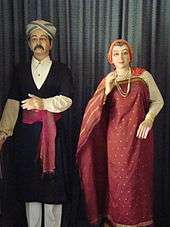
Attire
Kodavas have distinctive dresses, the men wearing wraparound robes called the Kupya (now only seen at ceremonial occasions), and the women with a distinctive style of wearing the sari. The Kodava woman wears a sari with the pleats at the back and the loose end pinned at the right shoulder. The men have many distinctive practices such as carrying ceremonial knives, and martial war dances.[21]
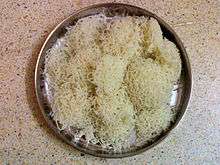
Cuisine
Boiled rice (koolu) and rice gruel (kanjee) formed the staple food of the Kodavas. The coconut, jackfruit, plantain, mango and other fruits and vegetables were widely used. Ghee was used in well-to-do families and on festive occasions. Rice in the form of Kanji or Koolu was served at meals along with curries and other additional dishes. Non-vegetarian food was not objectionable and alcoholic drinks as a rule weren't prohibited. Pork, chicken river fish, were commonly consumed as also were game meat. Sweet dishes like akki payasa were prepared during festive occasions. Other special dishes included otti (rice roti), paaputtu (similar to idli), noolputtu (rice noodles), thambuttu (a sweet), etc.[21]
Marriage
Girls and boys from one okka cannot marry within the same okka. However, cousin marriage between children of brother and sister is accepted (but not between children of two brothers or two sisters). Once married, a girl assumes the okka name of her husband. Unlike many other Hindu communities, a widow is still allowed to participate in happy occasions like marriages of her children. She is the principal figure to conduct the marriage ceremony that traditionally is conducted without a Brahmin priest. A widow is allowed to remarry and this is a common practice as it is fully accepted.[21]
Society

Organizational structure
Kodava settlements in Coorg are in the form of Okka family groups that are scattered across agricultural and forested holdings, where traditional Ainmane houses form focal meeting points in the rural landscape. It is a joint patrilineal clan with males of common ancestry. The male members of an okka share an okka name. Currently there are about 1000 okka names and families in Kodagu. Traditionally all the members of an okka lived in a large ancestral Ainemane house (ayyangada mane – House of the Elders). The emergence of townships, as such, has been a relatively recent phenomenon and many of the main towns in Kodagu are inhabited by recent migrants and non-Kodavas. This cluster of homes and property form the nucleus of a village called ur. A group of ur or villages is called the nad. A number of nads make a sime. Traditionally there were eight simes in Kodagu. The land belonging to the okka is cultivated jointly by the family members and cannot be partitioned or sold. The oldest member of the family is the head of the okka and is called pattedara or koravukara. It is a hierarchy that is passed on to the eldest member of the clan by right. Similarly each ur (or ooru), nad and sime has a headman called as takka. The takkas settled disputes and imparted justice after consultation with other elders.[21]
Festivals

Kodava festivities center around their agriculture and military tradition. Originally most of their lives were spent in the field: cultivating, harvesting and guarding their fields from the depredations of wild animals, or otherwise they were either waging war or hunting for game. Their new year was originally celebrated on Bishu Changrandi (called Vishu in Kerala and South Canara). The Kodavas began to celebrate a few Hindu festivals such as Ugadi, Ayudha Puja (Dasara, also called Navratri, Vijaydashami, Durga Puja or Dussehra) and Mahashivaratri under the Haleri Rajas(1602–1834). However Kodavas traditionally celebrate the following three main festivals peculiar to Kodagu alone (two are cultural and one religious):
Kailpoldu (Festival of Arms)
Kailpoldu is celebrated on 3 September. Officially, the festival begins on the 18th day after the sun enters the Simha Raasi (the Western sign of Leo). Kail means weapon or armoury and Pold means festival. The day signifies the completion of "nati" – meaning the transplantation of the rice (paddy) crop. The festival signifies the day when men should prepare to guard their crop from wild boars and other animals, since during the preceding months, in which the family were engaged in the fields, all weapons were normally deposited in the "Kanni Kombare", or the prayer room. Hence on the day of Kailpoldu, the weapons are taken out of the Pooja room, cleaned and decorated with flowers. They are then kept in the "Nellakki Nadubade", the central hall of the house and the place of community worship. Each member of the family has a bath, after which they worship the weapons. Feasting and drinking follow. The eldest member of the family hands a gun to the senior member of the family, signifying the commencement of the festivities. The Menu for the day is Kadumbutte (Rice balls) and Pandhi Curry (Pork Curry) and Alcoholic beverages are also served. The whole family assembles in the "Mand" (open ground), where physical contests and sports, including marksmanship, are conducted. In the past the hunting and cooking of wild game was part of the celebration, but today shooting skills are tested by firing at a coconut tied onto the branch of a tall tree. Traditional rural sports, like grabbing a coconut from the hands of a group of 8–10 people (thenge porata), throwing a stone the size of a cricket ball at a coconut from a distance of 10–15 paces (thenge eed), lifting a stone ball of 30–40 cm lying at one's feet and throwing it backwards over the shoulders, etc., are now conducted in community groups called Kodava Samajas in towns and cities.[1]
Kaveri Sankramana (worship of river Kaveri)
The Kaveri Sankramana festival normally takes place in mid-October. It is associated with the river Kaveri, which flows through the district from its source at Talakaveri.At a predetermined time, when the sun enters Tula Rasi (Tula sankramana), a fountain from a small tank fills the larger holy tank at Talakaveri. Thousands of people gather to dip in this holy water. The water is collected in bottles and reaches every home throughout Kodagu. This holy water is called Theertha, and is preserved in all Kodava homes. A spoonful of this water is fed to the dying, in the belief that they will attain moksha (spiritual emancipation) and gain entry to heaven. On this day, married women wearing new silk saris perform puja to a vegetable, symbolising the goddess Kaveri. The vegetable is usually a cucumber or a coconut, wrapped in a piece of red silk cloth and decorated with flowers and jewels (mainly 'Pathak' (Kodava Mangalasuthra)). This is called the Kanni Puje. The word Kanni denotes the goddess Parvati, who incarnated as Kaveri. Three sets of betel leaves and areca nut are kept in front of the goddess with bunches of glass bangles. All the members of the family pray to the goddess by throwing rice and prostrating themselves before the image. The elder members of the family ceremonially bless the younger. Then an older married woman draws water from the well and starts cooking. The menu of the day is dosa and vegetable curry (usually pumpkin curry (kumbala kari) ) and payasa. Nothing but vegetarian food is cooked on this day, and this is the only festival which is strictly vegetarian. Alcohol is prohibited. The Kaveri cult has its center and origin in Kodagu. It is only those Kodava rites associated with the river Kaveri that are Brahmanical in influence.[1]
Puttari (Harvest festival)
Puttari means "new rice" and is the rice harvest festival (also called Huttari in Kannada). This takes place in late November or early December. Celebrations and preparations for this festival start a week in advance. On the day of Puttari, the whole family assembles in their ain mane (the common family house), which is decorated with flowers and green mango and banana leaves. Specific foods are prepared: thambuttu, puttari, kari and poli poli. Then the eldest member of the family hands a sickle to the head of the family and one of the women leads a procession to the paddy fields with a lit lamp in her hands. The path leading to the field is decorated. A gunshot is fired to mark the beginning of the harvest, with chanting of "Poli Poli Deva" (prosperity) by all present. Then the symbolic harvesting of the crop begins. The rice is cut and stacked and tied in odd numbers and is carried home to be offered to the gods. The younger generation then lite fire crackers and revel, symbolising prosperity. Groups of youngsters visit neighbouring houses and show off their dancing skills and are given monetary gifts. A week later, this money is pooled and the entire village celebrates a communal dinner. All family members gather for this meal. Dinner normally consists of meat dishes, such as pork, and mutton curry. Alcoholic beverages are also served at such feasts in Coorg.[1]
Religion
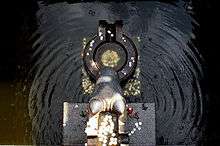
Shrines and deities
The Kodavas of Kodagu are Hindus; they are polytheists who believe in reincarnation, revere the cow and originally worshipped the natural elements and their ancestors. chief deities are Bhagwathi (Parvati), Mahadeva (Shiva), Bhadrakali (a form of Parvati as Kali or Durga), Subramani (Subramanya, Karthik or Muruga), Aiyappa and Muthappa . Igguthappa, the most important local God, is an incarnation of Lord Subramani, the God of snakes, rain, harvest and rice (Incidentally, the famous Kukke Subramani temple located near Kodagu is dedicated to snakes, hence Subramani is the God of snakes despite the misconception that his carrier, the peacock, which eats grains and insects, is wrongly believed to kill and eat snakes). The reverence of various spirits in addition to the established gods of Hinduism is also part of their religion. This is similar to the bhuta aradhana of Tulunad. There are many spirits worshipped in Kodagu. The Kodavas also practised snake worship. While consumption of soma (liquor) and pork is permitted, that of beef is strictly prohibited. They maintained sacred groves on their public village lands from ancient times, hunting and cutting trees was prohibited in these woods called the Devakadu. However these days the government and private speculative land buyers have acquired these sacred groves and converted them into farms for monetary gains and with disrespect towards native religious feelings. The Kodavas believe in astrology as well. Generally they don't follow idol worship but believe in nature worship.[1]
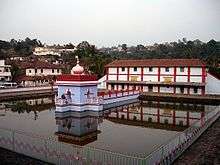
On their ancestral clan lands they have a shrine (Kaimada), which is the shrine of the clan's first ancestor (Guru Karana - Karana),where they offer prayers and obeisance. The spirits of departed souls who were prominent figures in the community and had done good deeds while they were alive were worshipped. These spirit gods do not have a set form of physical representation. Symbolically a piece of rock is sanctified and considered as such a spirit deity. A number of weapons, made of wood or metal, are kept in the Kaimadas. The shrine is usually made of clay or wood or covered with sheet metal, and housed within a roofed structure built near the entrance to the ain-mane. The founder of each clan (Okka), the Guru Karana, is worshipped by the members of that particular clan. Sometimes it is simply kept on a platform under a sap-exuding tree near the entrance of ainemane. Some clans conduct a karana kola, a dance of the ancestral spirit during which a Malayalee migrant dresses in elaborate colourful clothing and dances in a trance and acts as an oracle. During this ceremony he is symbolically possessed by the karana, the original founder of the particular clan.[1]
In every home a lamp called Nellakki Bolucha is lit in honour of the Guru Karana. The lamp in the central hall is lit by the embers of the kitchen hearth every day. Kodavas were also nature worshippers revering sun, moon, earth, water and fire. Fire of the kitchen hearth is especially sacred. Each village had a Bhagwathi, each lane had a snake deity and each nad(region) had an Aiyappa. The Kodavas worshipped Mahadeva as well. Some of the main shrines of the Kodavas are the temples of Talakaveri, Bhagamandala, Padi Igguthappa, Peggala (Heggala), Kakot Parambu and Bythoor. The Kodavas also revere and visit the shrines of Kukke Subramanya and Dharmasthala Manjunatha in Tulunad.[1]
Socio-religious link with North Malabar
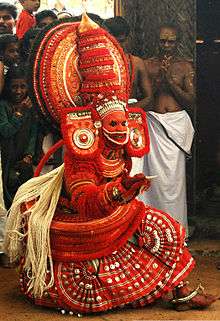
The word Kodakar was the Malayalam word for a Kodava, and it comes from the word "Kodag-kara". The ancient Kodavas of Kodagu had land trade with Northern Malabar, especially with Thalassery (Tellicherry) port on the coast, and would also go on regular pilgrimage to the temples of the region. Devotees from Kodagu were, and still are, frequent visitors to the temples of Kannur and Waynad (districts of North Kerala). These temples are in places like Baithur or Bythoor (Vayathur and Ulikkal), Payyavoor, Parassinikkadavu, Thirunelli, Kanjirath, Nileshwar and Payyanur. Also the Nambima (Namboothiri) priests of North Malabar traditionally served as the temple priests in the temples of Kodagu. The folk songs of the Kodavas speak of the temple deities having originated in North Malabar. These folk songs while talking of Kodagu and its people also mention the temple regions as well as the Thiyya, Nambiya (Nambiar), the Nambima (Namboothiri) and the Nayamma (the Kodava word for Nair - in Malayalam Nayanmmar means Nairs) people of Northern Malabar.
Baithurappa (Bythoorappa) is a chief deity of the Kodavas. The Puggera family of Kodavas were hereditary temple managers at the Bythoor (Vayathur, in Kerala and near Karnataka's Kodagu border) temple which was in the dominion of the Kalliat Nambiar, who like the Kolathiri (Chera Raja) was an ally of the Kodavas. Every year Kodavas from Southern Kodagu pilgrimage to this place. Likewise the Bovverianda and the Mundiolanda families of Kodavas were the hereditary temple managers at the Payyavur temple which was under the Kolathiri (Chera) kings. This is because a few of the Kodavas lived in North Malabar in the Taliparamba (ancient capital of the Cheras) region in the ancient past and fought on their side as mercenary soldiers.[1]
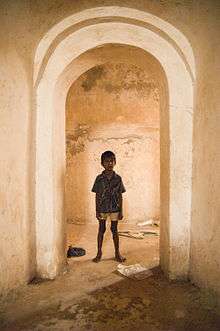
Firearms
The Kodavas revered weapons, such as guns and the traditional sword and dagger, which are essential for their ceremonial purposes and in accordance to their religious and cultural customs.[1] The Kodavas stood guard at the Mysore, Mangalore and Malabar boundary posts. The support of the Kodagu native police, army and offices, held by Jamma ryots (native militia farmers, also called jamma tenure-holders), who were mostly Kodavas while including people from a few other communities as well, exempted the Kodavas from the 1861 Indian Arms Act.[22] The 1878 Indian Arms Act listed among those groups of persons not restricted by the Act: "all persons of Kodava race, and all jumma tenure-holders in Coorg who by their tenures are liable for police and military duties."[23]
Language and literature
The Kodava language, called Kodava takk, is a form of an old form of Kannada and thus has quite a few words from languages of neighboring states as Kannada may have been influenced by them those days. Kodava takk has a lot of similarity in accent and pronunciation with that of Beary bashe, a dialect spoken by Bearys of Coastal Karnataka.[1]
Family histories, rituals and other records were scripted on palm leaves by astrologers. These ancient, scripted leaves called Pattole (patt=palm, ole=leaf) are still preserved at Kodava Ainmanes. Appaneravanda Hardas Appachcha Kavi and Nadikerianda Chinnappa are the two important poets and writers of Kodava language. The Pattole Palame, a collection of Kodava folksongs and traditions compiled in the early 1900s by Nadikerianda Chinnappa, was first published in 1924. The most important Kodava literature, it is said to be one of the earliest, if not the earliest, collection of the folklore of a community in an Indian language. The fourth edition of the Pattole Palame was published in 2002 by the Karnataka Kodava Sahitya Academy. Nearly two thirds of the book consists of folksongs that were handed down orally through generations. Many of these songs are sung even today during marriage and death ceremonies, during our festivals relating to the seasons and during festivals in honour of local deities and heroes. Traditionally known as Balo Pat, these songs are sung by four men who beat dudis (drums) as they sing. The songs have haunting melodies and evoke memories of times long past. Kodava folk dances are performed to the beat of many of these songs. The Pattole Palame was written using the Kannada script originally; it has been translated into English by Boverianda Nanjamma and Chinnappa, grandchildren of Nadikerianda Chinnappa, and has been published by Rupa & Co., New Delhi.

Kodava people are the native speakers of Kodava language are origins of district of Kodagu.[24] As per 1991 census, the speakers of Kodava Takk make up to 0.25% of the total population of the Karnataka state. According to Karnataka Kodava Sahitya Academy, apart from Kodavas, 18 other ethnic groups speak Kodava Takk in and outside the district including Amma Kodavas, Kodava Heggade, Iri, Koyava, Banna, Madivala, Hajama, Kembatti, and Meda.[25] Though the language has no script, recently a German linguist by name Gregg M. Cox developed a new writing system for the language known as the Coorgi-Cox alphabet, used by a number of individuals within Kodagu.[26] Some films are also produced in this language portraying the tradition, culture and nativity of the Kodavas. Kodava Cinema industry is very small and in the year 1972 first Kodava film was produced named 'Nada Mann Nada Kool' directed by S.R.Rajan (1972).
Land and agriculture
Devarakadu

The Kodavas revered nature and their ancestors they formerly hunted for sport, the Kodavas would even conduct ceremonies symbolically uniting in marriage the spirits of killed tigers with the spirit of the hunter, highlighting the intimate relationship between Kodava culture and the wildlife living in their forest realm. Sacred groves, known as devarakadu (devara = God’s and kadu = forest), continue to be maintained in their natural state amongst the coffee plantations since the time of the Rajas.[27] Each village has at least one devarakadu, which is believed to be an abode of the gods, with strict laws and taboos against poaching and felling of trees. These groves are also an important storehouse of biodiversity in the district.[21]
Jamma
A system of land tenure, known as Jamma (privileged tenureship), was formerly instituted in Kodagu during the pre-colonial Paleri Dynasty of the Lingayat Rajas. Jamma agricultural lands were held almost exclusively by Kodavas as a hereditary right, and were both indivisible and inalienable. Importantly, rights over the adjacent uncultivated woods (bane) were also attached to Jamma tenure, such that relatively expansive agricultural-forestry estates have remained intact across Kodagu. The exclusion of plantation crops, such as coffee, from India’s Land Ceiling Act has further insulated these holdings from post independence land reform efforts across India. Importantly, rights over the adjacent forests (bane) were also attached to Jamma tenure, such that relatively expansive agricultural-forestry estates have remained intact across Kodagu. A unique feature of Jamma tenure is that tree rights remained with the Rajas, and were subsequently transferred to the colonial and post-independence governments and remains an import determinant of land use practices in the district.[21][27]
Coffee cultivation
Coffee cultivatuion is widely believed to have been introduced in the western ghats from the Yemeni port of Mocha by the Muslim saint, Baba Budan, in the 16th century and some time after its introduction, coffee cultivation was embraced by the Kodavas in western Karnataka. Following the British annexation of Kodagu in 1834, large numbers of European planters began settling in the forested mountains to cultivate coffee, dramatically changing the economic and environmental management structures of Kodava society.[27] Today, more than one third of India’s coffee is grown in Kodagu district, making it the most important coffee growing district in India, the world’s fifth largest coffee-producing country.[21]
Recent developments
Throughout the medieval period and until well into the 19th century, the Kodavas had a pre-eminent role in Kodagu. By the middle of the 19th century, however, this dominance started waning. British individuals bought large stretches of land in Coorg and founded plantations. Institutions like the joint family system began to disappear. A number of socio-religious reform movements in India took shape from the 1800s. The Kodavas also felt the need for reform in response to such changes. The sense of decline gave an impetus to the spirit of reform that expressed itself in the work of religious men like Sadguru Appayya Swami. Trouble arose for the community during the post-colonial years, after the Land Reform Act enacted in 1974. Many large land owners lost their lands to the tenants (land to the tiller) and the socio-economic structure of the prominent community of Kodavas changed irreversibly. These Land reforms led to massive loss of land-ownership by the Kodava gentry who were relegated to poverty overnight. The decline of Kodava dominance was however tempered by their conversion through the 20th century to the academic and professional classes and their dominance in Kodagu politics.
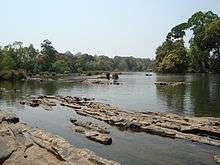
Efforts by community leaders have brought together all Kodava groups the world over under an umbrella " Federation of Kodava Samajas". It is a federation of about 27 Kodava Samajas and is headquartered at Balagodu, Virajpet Taluk, Kodagu District.
The foundation of the Coorg Association (predecessor of the Bangalore Kodava Samaj) was laid in Bangalore, in 1912. The Kodava Samaja (R),Bangalore is an organisation created for the traditional and cultural conservation, social well-being and welfare of the Kodava community. It is headquartered at Vasanthnagar in the city of Bangalore in Karnataka State, India. Expatriate Kodavas both in other states of India as well as in countries other than India have formed Kodava Samajas (Kodava Associations) in their states and countries of domicile. Examples are the Bangalore Kodava Samaja (already mentioned) with 33 branches in Bangalore City, the Mysore Kodava Samaja, the Canadian Kodavas in North America and the Muscat Kodavas of Oman. These associations of non Kodagu origin retain the cultural uniqueness of the Kodavas at the same time adapting many practices to the times and country of their adoption. Lately, some organisations including the Codava National Council (CNC) and Kodava Rashtriya Samiti are demanding Kodava homeland status and autonomy to Kodagu district.[28][29][30] The population of the Kodavas is around 1.5 lakh.[31]
Demographics and distribution
Kodavas Proper
The Kodava community numbers about one-fifth out of a total population of over 500,000, in Kodagu. They are the indigenous people of Kodagu, the land to which they gave their name. Many Kodava people have migrated to areas outside Kodagu, to other Indian cities and regions, predominantly to Bangalore, Mysore, Mangalore, Ooty, Chennai, Mumbai, Kerala, Hyderabad and Delhi for better job prospects. A few of them have now migrated outside India to foreign countries, like North America (the US and Canada), the Middle East (especially Dubai in UAE and Muscat in Oman), the UK and Australia (especially to Sydney where they are prominent members in the financial industry as well as contributing to the health industry).[8]
Amma Kodavas

Besides the Kodavas there were other indigenous people who followed the same culture and spoke the same Kodava language. One of them, the Amma Kodavas, were believed to be the original priests’ at all important temples in Coorg including temples of Talakaveri, Igguthappa and Irupu. The religious customs and practices of the hill people of Coorg gradually and subtly began to be influenced by the Brahmin practises and rituals. The role of the Coorg priest, via: Amma Kodavas declined and that of the Brahmin priest increased. In due course, the Amma Kodavas had no role to play in the religious aspects of the people of Coorg.
The loss of this important role earned some powerful Brahmin sympathisers, one of whom was a Havyaka Brahmin Thimmapaya, who had a large following of Amma Kodavas. During the later part of the 19th century, it appears that an attempt was made for assimilating the Amma Kodavas into the Brahmin fold. One batch of Amma Kodavas performed the rites to wear the sacred thread. Another batch is reported to have done so early in the 20th Century. Both these batches were assigned the Gothra names of their Brahmin patrons. The process of assimilation did not move any further. Today, many of the Amma Kodavas wear the sacred thread, a large number of them performing the rites a day before marriage (not after puberty, as done by the mainstream Brahmins). There are as many, who do not wear the sacred thread. Some of the Amma Kodavas do not have gotras assigned to them. They are vegetarians and endogamous. However, all other social activities such as marriage, dress and festivals are similar to the Kodavas. [32]
Kodava Heggade
The Kodava Heggades (Peggades) are another of these indigenous castes of Coorg although originally they were believed to have come from North Malabar. They have around 100 Family names. They follow the Kodava habits and customs, dress like other Kodavas and speak Kodava Takk. The Kodava Heggades and the Amma Kodavas are similar to the Kodavas and hence might have been related to them in the ancient past.[32]
Kodava Maaples
Kodava Maaple is a Muslim community residing in Kodagu district of Karnataka State in southern India. In Coorg many Kodavas were converted into Islam during the rule of Tippu Sultan in Coorg. They are called the 'Kodava Maaple' or 'Jamma Maaples' ( not to be confused with the Kerala Mappillas). However some of the Kodava Maaples have married with the Kerala Mappilas and Mangalore Bearys. They contract marriage alliances with the Muslims of Coorg, Mangalore and Kerala. The Kodava Maaples belong to Sunni Islam, refrain from alcohol and eat only Halal. They maintained their original Kodava clan names and dress habits and spoke Coorg language although now they do follow some Kerala Muslim and Beary customs also.
Others
These include communities such as, Kodava Nair, Koleya, Airi, Malekudiya, Meda, Kembatti, Kapala, Kavadi, Kolla, Koyava, Banna, Golla, Kanya, Maleya and others. Many of these communities had migrated into Kodagu from the Canara, Mysore and the Malabar regions during the period of Haleri Dynasty and to a certain extent culturally ingrained themselves in the Kodava Society. They speak Kodava takk and follow the Kodava customs and habits to some extent. [33]
Kodagu Gowdas were Tulu origin Gowdas who came from Sulya in South Canara and were settled in Kodagu by the Kodagu Rajas in around 1800 AD. The Rajas of Kodagu had to bring in Tulu Gowdas from Sulya and others to settle down in some of the deserted farms of the dead Kodava families to continue the economic activities of the region. These Tulu Gowdas from Sulya became the Kodagu Gowda. They speak Are Bhashe (Kodagu Gowda 'half-tongue', an admixture of Tulu, Kodava language and Kannada). The Brahmins from neighbouring North Malabar served as temple priests in Coorg but didn't possess land in Coorg.[27]
Caste Reservations
Around 2000, some of the Kodava language speakers were included in the Other Backward Classes list of Karnataka. The Kodavas were listed as Kodagaru (a derogatory term)[34] under the Category III A of the Other Backwards Caste (OBC) List of Karnataka State Government.[35] The Coorg National Council had appealed to the State Government to correct this and mention them as Kodavas and to include them in the Central Government Other Backward Castes (OBC) List.[31][36]
Among the other castes included in the Category III A of the State OBC List are the Gowda Vokkaliga.[35][37] The Amma Kodava, the Kodagu Banna and the Kodagu Heggade have been included under the Category II A of the State OBC list, while the Kodagu Kapala have been included under Category I A of the State OBC List.[35]
Eminent Kodavas
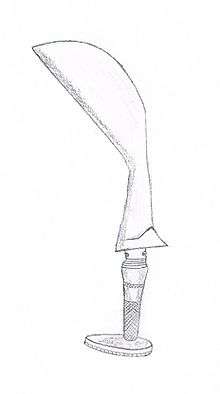
The Kodavas have contributed immensely towards the growth of the Indian nation, despite them being in small numbers. Their most significant contributions are in the armed forces and in sports. Originally being land-owning militiamen farmers from Kodagu, hence their traditional twin occupations were as agriculturists and as soldiers. The distinguished among them had been local chieftains, palace officials, officers of the Raja's army and brave battle veterans, therefore invariably having attained fame in either government service or in the local army. The Kodava ancestors grew paddy and plantation crops like bananas and pepper, their descendants are now into coffee cultivation.
Army
Many Kodavas joined the Indian armed forces both as officers and as servicemen. They distinguished themselves in times of war and peace, army-men are still shown the most respect in Kodagu (Coorg). Quite a number of Kodavas have been martyred on enemy frontiers. Many Kodavas participated in the two World Wars before Indian Independence and in the wars against China and Pakistan after 1947. There was a separate Coorg regiment (now forming a unit of the Indian Regiment of Artillery, this unit being called the 37 (Coorg) Anti-Tank Regiment RIA) which largely included people from non-Kodava backgrounds while the Kodavas themselves served in different other regiments; this is in keeping with the army's non-bias policy according to which people were recruited in regiments other than those belonging to their region and community of birth. Hence Field Marshal Cariappa of the Rajput Regiment and General Thimayya of the Kumaon Regiment were the most distinguished army-men among the Kodavas. Many other Kodavas have been made Lt. Generals, Major Generals, Brigadiers and Air Marshals. Lt. General A. C. Iyappa (or Apparanda Aiyappa) is best remembered for his contributions towards the Corps of Signals and towards Bharat Electronics Limited. There were several war heroes as well such as Nadikerianda Bheemaiah, a JCO who was awarded the Vir Chakra for conspicuous bravery in J&K Operations in 1947, Air Marshal Cheppudira D Subbaia who was a fighter pilot during WW II and was awarded the Vir Chakra and the PVSM, Squadron Leader Ajjamada B Devaiah, (known as the 'wings of fire') another fighter pilot was awarded the Maha Vir Chakra after he shot down an enemy aircraft and died in Pakistan during the 1965 Indo Pak War, Major Ganapathi Puttichanda Somiah, (known as the 'Major who kept his cool') awarded the Maha Vir Chakra, during the Indian Intervention in Sri Lanka, Major Ranjan Chengappa, Shaurya Chakra Awardee who was in Congo for UN mission as part of a peace keeping force, Col Chembanda M Thimanna, awarded the Shaurya Chakra for bravery in counter insurgency operations, Major Chottangada Ganesh Madappa, was awarded Shaurya Chakra posthumously in 1996, Squadron Leader Mandepanda Appachu Ganapathy, awarded the Vir Chakra in 1972 (when as a Flight Lieutenant he shot down Pakistani Sabre Jets). Major (now Retd Maj Gen) K P Nanjappa was awarded the Vir Chakra in 1971.
Hockey
Kodavas have a long history of association with the game of field hockey. The district of Kodagu is considered as the cradle of Indian hockey.[38][39] More than 50 Kodavas have represented India in international hockey tournaments, M. P. Ganesh, M.M Somaiah, B. K. Subramani, A. B. Subbaiah, K. K. Poonacha, C. S. Poonacha, Jagadish Ponnappa, M.A.Bopanna, Len Ayyappa, Amar Aiyamma to name a few, out of whom 7 have also participated in the Olympics.[38] The passion for hockey in Kodagu is so much that teams representing more than each of 200 families participate in an annual Kodava Hockey Festival. This festival is recognised as one of the largest field hockey tournaments in the world and has been referred to the Guinness Book of Records.[38] However it has already found a mention in the Limca Book of Records, which is an Indian variant of the Guinness Book.[38]
Other Sports
Kodavas have also been known in other individual sport events as well especially in athletics; Ashwini Nachappa, National Champion in Athletics, Olympian and Arjuna Awardee, Rohan Bopanna, National Tennis Champion, Joshna Chinappa, Ace squash player, Jagat and Anita Nanjappa, motor racing champions, C.C. Machaiah, (Chenanda Machiah) National boxing Champion, Olympian and Arjuna Awardee, Reeth Abraham (née Devaiah; of Kodava parentage), National Athletics Champion, Arjuna Awardee and Olympian, Arjun Devaiah, National Athlete and Arjuna Award winner, Pramila Aiyappa (née Ganapathy), National Champion in Athletics and Olympian, P G Chengappa, Former National Badminton Player, M R Poovamma (Maachettira Poovamma), National Champion in Athletics and Olympian and Ashwini Ponnappa, national badminton player. Of late Kodavas have begun to distinguish themselves in cricket. Robin Uthappa, K. P. Appanna, N. C. Aiyappa and Shyam Ponnappa have represented Karnataka state in national tournaments, like the Ranji trophy, and Bangalore city in the Indian Premier League.
Other fields
The Kodavas language was a spoken language and had no written literature until 1900. Appanervanda Haridasa Appachcha Kavi, Nadikerianda Chinnappa and Dr. I M Muthanna, have contributed immensely towards developing a literature for this language. The Kodavas are almost all Hindus a few of them had taken up monkhood and contributed towards the development of the religion, especially in Kodagu and Mysore regions, the most famous among them being Swami Shambhavananda, Sadguru Appayya Swami and Swami Narayanananda. In the government service as well there were many prominent Kodavas. One remembers Rao Bahadur IGP P.K.Monnappa, for his contributions towards the Indian Police in South India, be it in Hyderabad, Madras, Mysore or Coorg. Diwan Bahadur Ketoli Chengappa, was the last Chief Commissioner (the governor of a British province which had no elected assembly) of Coorg. There were others like Rai Saheb Muthanna who served in Ceylon (Sri Lanka) and Mesopotamia (Iraq) during WWII and Rao Saheb Pattamada Devaiah, SP of Coorg. Some were judges in the High Court, such as Palecanda Medappa for Mysore and Ajjikuttira S Bopantna for Karnataka. C M Poonacha had been the Chief Minister of Coorg State (1952–'56), MP, Union Minister and later Governor of Orissa and Madhya Pradesh. C B Muthamma was the first woman Indian Foreign Service officer.[40]Priya cg state level basketball player who represented Karnataka .
See also
References
- 1 2 3 4 5 6 7 8 9 10 11 B. D. Ganapathy (1967). Kodavas (Coorgs), their customs and culture. copies available at Kodagu. p. 28. Retrieved 23 August 2011.
- ↑ Jeff Neilson; Bill Pritchard (27 March 2009). Value chain struggles: institutions and governance in the plantation districts of South India. Wiley-Blackwell. pp. 174–. ISBN 978-1-4051-7393-3. Retrieved 23 August 2011.
- ↑ Kumar Suresh Singh; Anthropological Survey of India (2003). People of India. Anthropological Survey of India. p. 751. ISBN 978-81-85938-98-1. Retrieved 23 August 2011.
- ↑ Muthamma, C. B. "A search for roots". India Today. Retrieved 11 June 2015.
- ↑ Appaiah, Prof. P. S. History of Kodagu (until 1600).
- 1 2 3 4 5 6 Kamath, Dr. S. U. (1993). Karnataka State Gazetteer: Kodagu District. Bangalore: Government Press. p. 160.
- 1 2 Kushalappa, M. "The Early Coorgs", 2013.
- 1 2 K.S. Rajyashree. Kodava Speech Community: an ethnolinguistic study. LanguageIndia.com, October 2001
- ↑ Bowring, L (1872). Eastern Experiences. London: Henry S. King. p. 240.
- ↑ Gazetteer of Coorg (Rev.G.Richter,1870)
- ↑ Lewis Rice. Mysore and Coorg gazette (PDF). p. 103.
- 1 2 Hunter, Sir W. W. The Imperial gazetteer of India (1907). Great Britain: Oxford. Retrieved 11 August 2014.
- ↑ Richter, G (1870). Manual of Coorg. Stolz. p. 337. Retrieved 14 August 2014.
- ↑ Kushalappa, Mookonda (2013). Long ago in Coorg.
- ↑ Bhat, N. Shyam. South Kanara, 1799-1860. Books.google.co.in. Retrieved 2012-06-01.
- ↑ Thurston, Edgar (1913). The Madras Presidency with Mysore, Coorg and Associated States. Cambridge University
- 1 2 "Coorg (district, India)". Britannica Online Encyclopedia. Retrieved 2012-06-01.
- ↑ Youth Club, Bhagavathi. "Remembering those who fought for Freedom". Blogspot. Retrieved 23 October 2013.
- ↑ Correspondent, Staff. "Remembering those who fought for freedom". The Hindu. Retrieved 11 August 2014.
- ↑ "Freedom fighters' bhavan". Deccan Herald. Retrieved 11 August 2014.
- 1 2 3 4 5 6 7 Kodavas (Coorgs), their customs and culture (B.D. Ganapathy)
- ↑ I. M. Muthanna (1971). The Coorg memoirs (the story of the Kodavas): Muthanna speaks out. Copies available at Usha Press. p. 246. Retrieved 22 July 2011.
- ↑ Punjab (India); Sir Henry Adolphus Byden Rattigan; Alweyne Turner; North-west Frontier Province (India) (1897). The Bengal regulations: the acts of the governor-general in council, and the frontier regulations ... applicable to the Punjab, with notes and an index. Civil and Military Gazette Press. pp. 1189–. Retrieved 22 July 2011. Cite uses deprecated parameter
|coauthors=(help) - ↑ "Kodava-speaking people seek one identity". The Hindu.
- ↑ "Will Kodava find a place in Eighth Schedule?". The Hindu.
- ↑ "Debate on Kodava script continues". The Hindu. German multi-linguist devises a script with 34 alphabets
- 1 2 3 4 Gazetteer of Coorg (Rev.G.Richter,1870)
- ↑ "Codava National Council sets up global forum". The Hindu.
- ↑ "Dharna staged for Kodagu State". The Hindu.
- ↑ Correspondent, DNA (22 March 2014). "Lok Sabha elections 2014: Separatist movements at the fore in Karnataka". DNA. DNA. Retrieved 17 September 2014.
- 1 2 CHINNAPPA, JEEVAN (30 August 2010). "Will Kodavas be included in Central OBC list?". The Hindu. Retrieved 17 September 2014.
- 1 2 1. B.L.Rice, Mysore & Coorg Gazetteer, Vol-III. published in 1878, 2. Rev.H. Moegling "Coorg Memoirs" published as in 1855. 3. M.N.Srinivas, ‘Religion and Society among the Coorgs of South India’ published in Oxford in 1951.
- ↑ Lewis Rice. Mysore and Coorg gazette (PDF). p. 212 and 213.
- ↑ "Stick to the term 'Kodava': CNC". The Hindu. 2 October 2007. Retrieved 17 September 2014.
- 1 2 3 "CASTE LIST Government Order No.SWD 225 BCA 2000,Dated:30th March 2002.". KPSC. Karnataka Government. Retrieved 17 September 2014.
- ↑ Correspondent, Staff (22 July 2008). "Plea to accord OBC status to Kodava community". The Hindu. Retrieved 17 September 2014.
- ↑ "Govt okays plea to mention 'Kodavaru' in caste certificate". Deccan Herald. 17 August 2012. Retrieved 17 September 2014.
- 1 2 3 4 "Time-out". Online Edition of The Hindu, dated 2004-06-13. Chennai, India: 2004, The Hindu. 13 June 2004. Retrieved 21 June 2007.
- ↑ "Coorg: A nursery of Indian hockey". Online Edition of The Deccan Herald, dated 2006-04-04. 2005, The Printers (Mysore) Private Ltd. Retrieved 21 June 2007.
- ↑ Ponnappa, Lt. Col. A Study of the Coorgs.
External links
| Wikimedia Commons has media related to Kodava people. |